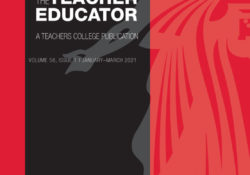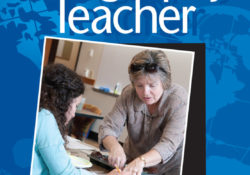eric.ed.gov har udgivet: This report presents findings, after one year of program implementation, from the Evaluation of Enhanced Academic Instruction in After-School Programs–a two-year intervention and random assignment evaluation of adapted models of regular-school-day math and reading instruction in after-school settings for students in grades 2 through 5. This evaluation seeks to determine whether the enhanced after-school instruction improves math or reading proficiency over what students would achieve in regular after-school programs, as measured by test scores. The evaluation also examines the impacts of the enhanced after-school instruction for subgroups of students based on their prior academic performance and grade level. The evaluation seeks to ascertain whether the enhanced after-school instruction affects other in-school academic behavior outcomes, as measured by reports from regular-school-day teachers of student engagement, behavior, and homework… Continue Reading →
Like this:
Like Loading...
eric.ed.gov har udgivet: The development of an assessment tool to measure the quality of instruction is necessary to provide an informative accountability system in education. Such a tool should be capable of characterizing the quality of teaching and learning that occurs in actual classrooms, schools, or districts. The purpose of this paper is to describe the development of the Academic Rigor in Mathematics (AR-Math) rubrics of the Instructional Quality Assessment Toolkit and to share the findings from a small pilot study conducted in the Spring of 2003. The study described in this paper examined the instructional quality of mathematics programs in elementary classrooms in two urban school districts. The study assessed the reliability of the AR-Math rubrics, the ability of the AR-Math rubrics to distinguish important difference between districts, the… Continue Reading →
Like this:
Like Loading...
eric.ed.gov har udgivet: This study evaluated an instructional model entitled “Integrating Computer Software into the Functional Mathematics Curriculum: A Diagnostic Approach,” which was intended to prepare middle-school special education students for the Maryland Functional Mathematics Test. The model consisted of eight major components: pretests/posttests, diagnostic evaluations, domain directories, software matrix, software summaries, skill sheets, computer software, and miscellaneous materials. The model was evaluated by comparing math performance and attitudes of students who received instruction based on the model with those of matched control students, and by conducting interviews with teachers using the model. Analysis of scores of 26 experimental and 26 comparison subjects on the 9th-grade Maryland Functional Mathematics Test indicated that 27% of experimental subjects passed the test, while 12% of the comparison students passed. Interviews with 17 teachers… Continue Reading →
Like this:
Like Loading...
tandfonline.com har udgivet en rapport under søgningen “Teacher Education Mathematics”: Abstract Abstract Differentiated instruction occurs when teachers use students’ level of readiness, interests, and learning preferences to adjust the content, process, or products, which increases engagement and academic performance. However, teachers cannot offer every form of differentiation to every student all the time. There exist limits of resources as well as an essential balance that teachers need to make in terms of benefits for student learning on the one hand and classroom efficiency on the other. Additionally, the choices teachers make in terms of differentiation are also rooted in and stem from their personal beliefs systems. The goal of this research was to investigate teachers’ preferences for differentiating their instruction by using Q methodology. 32 teachers, coming from a single… Continue Reading →
Like this:
Like Loading...
eric.ed.gov har udgivet: The purpose of this study was to measure the effects of tutoring low achievers on the concepts of carrying and borrowing before they were introduced in the classroom. Twelve low-achieving second-grade students were tutored on these concepts. The tutored children, along with members of two control groups, participated in a pretest covering these ideas. After the two-week tutoring period, members of all three groups participated in a mock classroom. The pre-remediated children performed significantly better than control group members on both types of problems (p less than .01), as well as in classroom participation (p less than .05). (Author/SD) Link til kilde
Like this:
Like Loading...
eric.ed.gov har udgivet: The purpose of this study is to illuminate the reciprocal relation between teacher leaders’ perception and practice to subject matter. The researcher conducted interviews and observations of 30 teachers from 8 urban elementary schools. The data and results evidently identify those teachers’ views of subject matter both shaped and were shaped by their teaching strategies. Teachers’ strategies for improving math instruction focused on external supports such as professional training in mathematics and building skills through sequenced instruction and curriculum. In improving literacy instruction, teachers emphasized the school community as the locus for development of literacy programs and materials that applied to a variety of academic subjects. (Contains 2 tables.) Link til kilde
Like this:
Like Loading...
eric.ed.gov har udgivet: This paper summarizes a formative evaluation of a developmental project designed to maximize the potential use of computers in mathematics instruction through the use of volunteers. The project was conducted using a 7th-grade class at an intermediate school in Utah. Data were analyzed for 12 students in a special class for students not having the necessary basic mathematics skills to enroll in a regular class. Students used math computer lab twice a week. The volunteers determined what mathematics skills each student needed to practice by referring to the student files, determined what software program would be appropriate for the student, and managed all the necessary student data. Both quantitative and qualitative data were analyzed for: (1) achievement; (2) attitude about mathematics; (3) mathematics anxiety; (4) study habits;… Continue Reading →
Like this:
Like Loading...
tandfonline.com har udgivet en rapport under søgningen “Teacher Education Mathematics”: Link til kilde
Like this:
Like Loading...
eric.ed.gov har udgivet: The “Clipboard Connection” is a methodology to facilitate the rapid circulation of relevant pre-existing materials from Chapter 1 Technical Assistance Centers of relevant materials from Chapter 1 Technical Assistance Centers (TACs) to their clients, teachers of educationally disadvantaged children in resource centers. Each “Clipboard Connection” consists of a lead sheet summarizing the contents of the materials (reprints of journal articles, brochures, etc.) to be distributed, and the materials themselves. This compilation focuses on techniques for effective mathematics instruction. The following reprints are included: (1) “Teaching Mathematics and Thinking,” prepared by Edward A. Silver and Margaret S. Smith (Arithmetic Teacher, volume 37, number 8, April 1990); (2) “Using Writing Activities to Reinforce Mathematics Instruction,” by David M. Davison and Daniel L. Pearce (Arithmetic Teacher, volume 35, number 8,… Continue Reading →
Like this:
Like Loading...
eric.ed.gov har udgivet: The report describes briefly two foundation-funded inservice training institutes for middle school teachers in Los Angeles (California) who have limited-English-speaking students in their classes. The first was designed to: (1) introduce teachers to the communicative approach to math and science instruction; (2) help develop instructional materials that encourage students to interact with the language of mathematics and science; (3) identify effective instructional and assessment practices for integrating content and language instruction; and (4) train selected teachers to become trainers and to assist in the design and implementation of the second institute. The project was linked to a federally funded program targeting English language acquisition and academic achievement, which allowed inclusion of social studies into the academic content. The first institute took place in November 1991, the second… Continue Reading →
Like this:
Like Loading...

